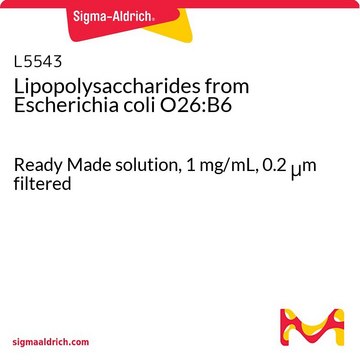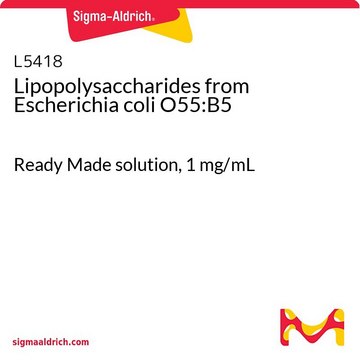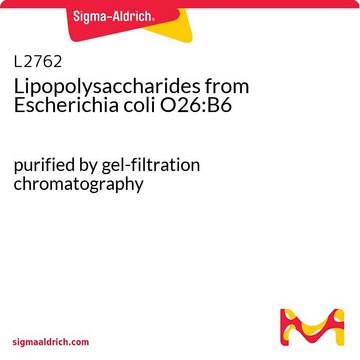L9641
Lipopolysaccharides (rough strains) from Escherichia coli EH100 (Ra mutant)
Synonym(e):
LPS
Anmeldenzur Ansicht organisationsspezifischer und vertraglich vereinbarter Preise
Alle Fotos(2)
About This Item
Empfohlene Produkte
Biologische Quelle
Escherichia coli (EH100 Ra mutant)
Qualitätsniveau
Form
lyophilized powder
Verunreinigungen
<3% Protein (Lowry)
Farbe
white to yellow
Löslichkeit
water: 4.90-5.10 mg/mL, cloudy to turbid, colorless to faintly yellow
Versandbedingung
ambient
Lagertemp.
2-8°C
Allgemeine Beschreibung
This product is phenol:chloroform:petroleum ether extracted from E. coli EH 100 (Ra mutant). The source strain is from a private collection.
Biochem./physiol. Wirkung
Lipopolysaccharides (LPS) are localized in the outer layer of the membrane and are, in noncapsulated strains, exposed on the cell surface. They contribute to the integrity of the outer membrane, and protect the cell against the action of bile salts and lipophilic antibiotics.
Angaben zur Herstellung
Prepared by phenol-chloroform-petroleum ether extraction.
The product is soluble in water (5 mg/ml) or cell culture medium (1 mg/ml) yielding a hazy, faint yellow solution. A more concentrated, though still hazy, solution (20 mg/ml) has been achieved in aqueous saline after vortexing and warming to 70-80 oC. Lipopolysaccharides are molecules that form micelles in every solvent. Hazy solutions are observed in water and phosphate buffered saline. Organic solvents do not give clearer solutions. Methanol yields a turbid suspension with floaters, while water yields a homogeneously hazy solution.
The product is soluble in water (5 mg/ml) or cell culture medium (1 mg/ml) yielding a hazy, faint yellow solution. A more concentrated, though still hazy, solution (20 mg/ml) has been achieved in aqueous saline after vortexing and warming to 70-80 oC. Lipopolysaccharides are molecules that form micelles in every solvent. Hazy solutions are observed in water and phosphate buffered saline. Organic solvents do not give clearer solutions. Methanol yields a turbid suspension with floaters, while water yields a homogeneously hazy solution.
Sonstige Hinweise
To gain a comprehensive understanding of our extensive range of Lipopolysaccharides for your research, we encourage you to visit our Carbohydrates Category page.
Signalwort
Danger
H-Sätze
Gefahreneinstufungen
Acute Tox. 2 Oral
Lagerklassenschlüssel
6.1A - Combustible acute toxic Cat. 1 and 2 / very toxic hazardous materials
WGK
WGK 3
Flammpunkt (°F)
Not applicable
Flammpunkt (°C)
Not applicable
Persönliche Schutzausrüstung
Eyeshields, Gloves, type N95 (US)
Hier finden Sie alle aktuellen Versionen:
Besitzen Sie dieses Produkt bereits?
In der Dokumentenbibliothek finden Sie die Dokumentation zu den Produkten, die Sie kürzlich erworben haben.
Kunden haben sich ebenfalls angesehen
Zhujun Yi et al.
Frontiers in immunology, 11, 595316-595316 (2021-02-06)
Pyruvate kinase M2 (PKM2) is a key glycolysis enzyme, and its effect on macrophages has not been entirely elucidated. Here, we identified that the PKM2 small-molecule agonist TEPP-46 mediated PKM2 activation by inducing the formation of PKM2 tetramer and promoted
Ji Hyung Kim et al.
PloS one, 7(9), e45348-e45348 (2012-10-03)
During interaction with APCs, invariant (i) NKT cells are thought to be indirectly activated by TLR4-dependently activated APCs. However, whether TLR4 directly activates iNKT cells is unknown. Therefore, the expression and function of TLR4 in iNKT cells were investigated. Flow
Sonia Zambrano et al.
Journal of the American Society of Nephrology : JASN, 30(9), 1573-1586 (2019-07-10)
Inflammatory processes play an important role in the pathogenesis of glomerulopathies. Finding novel ways to suppress glomerular inflammation may offer a new way to stop disease progression. However, the molecular mechanisms that initiate and drive inflammation in the glomerulus are
Kelly M DeMars et al.
Biochemical and biophysical research communications, 497(1), 410-415 (2018-02-16)
Bromodomain and extraterminal (BET) proteins are essential to pro-inflammatory gene transcription. The BET family proteins, BRD2, BRD3, BRD4, and testis-specific BRDT, couple chromatin remodeling to gene transcription, acting as histone acetyltransferases, scaffolds for transcription complexes, and markers of histone acetylation.
Unser Team von Wissenschaftlern verfügt über Erfahrung in allen Forschungsbereichen einschließlich Life Science, Materialwissenschaften, chemischer Synthese, Chromatographie, Analytik und vielen mehr..
Setzen Sie sich mit dem technischen Dienst in Verbindung.





